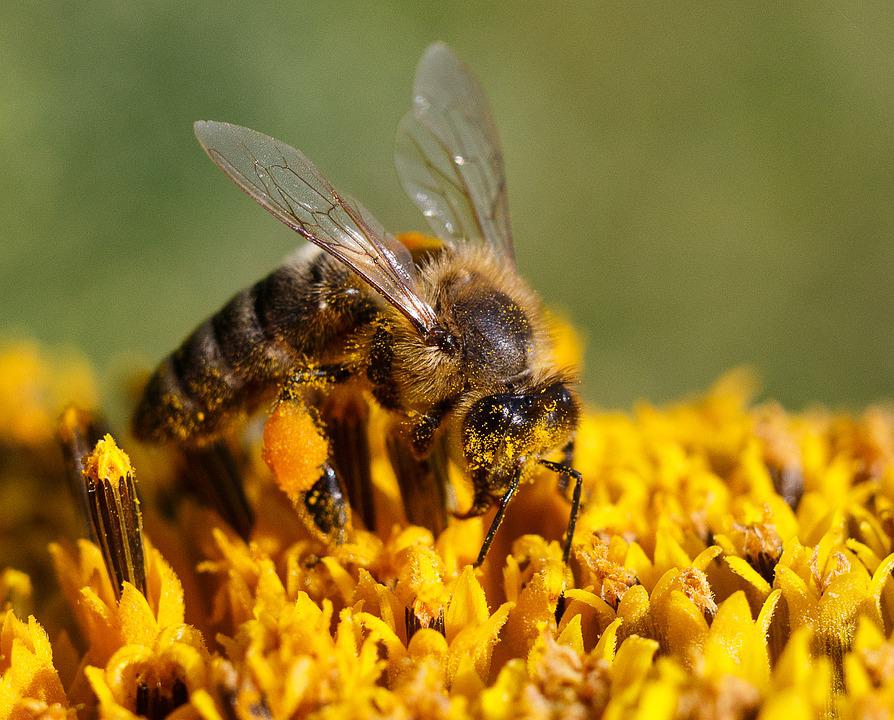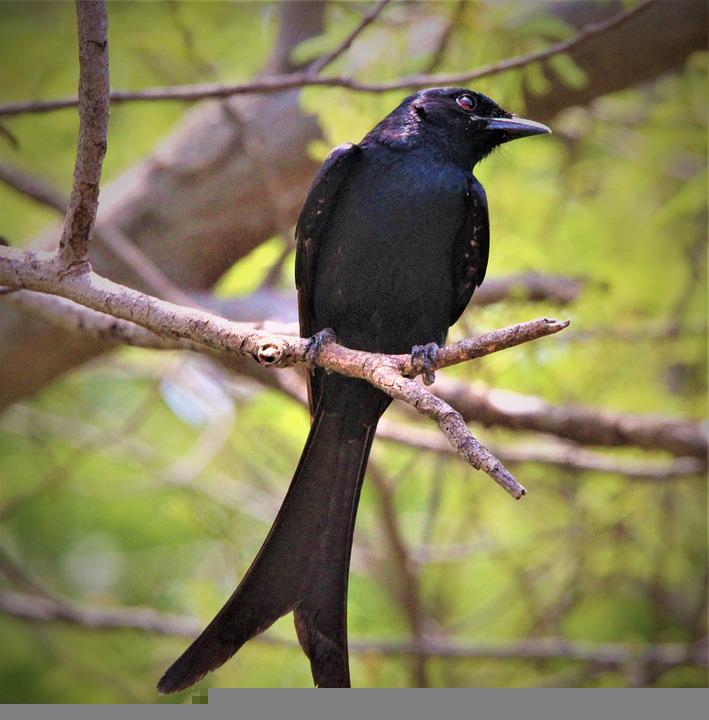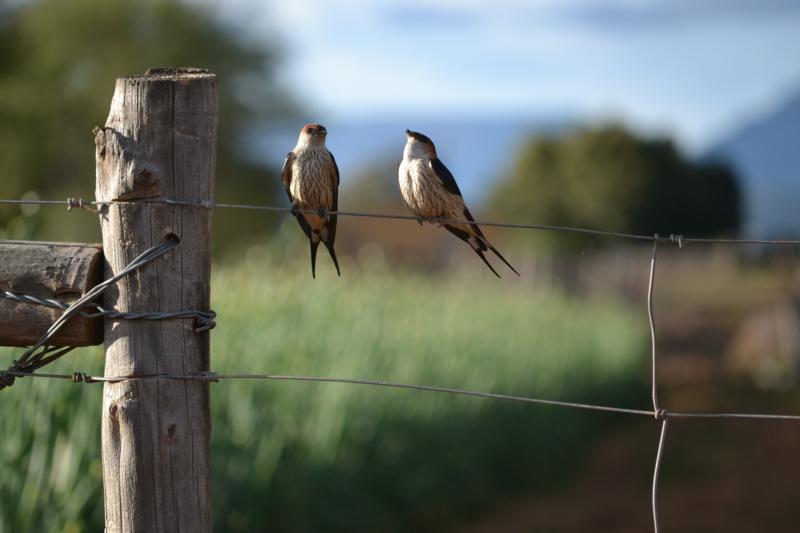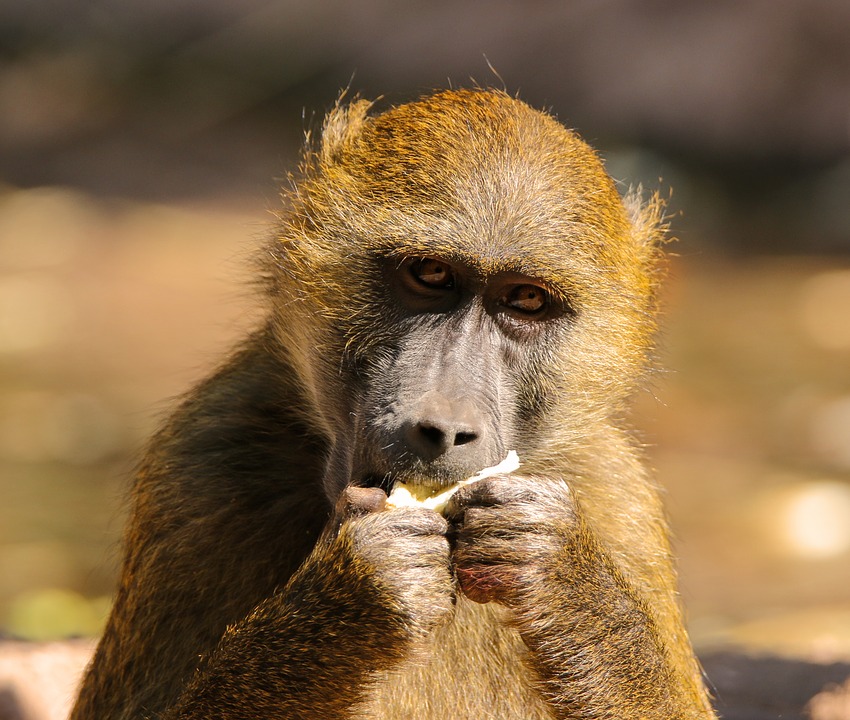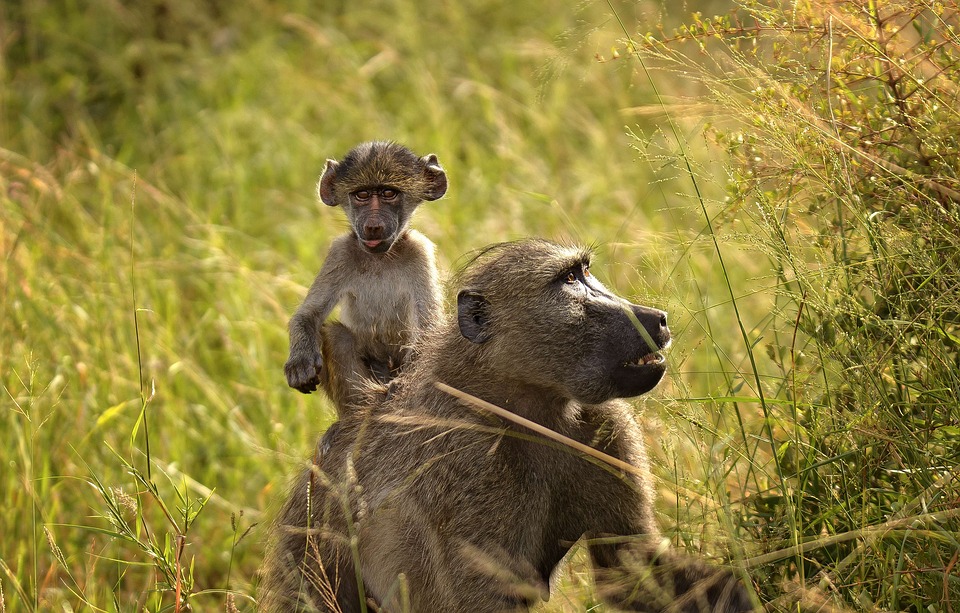A beekeeper faces many challenges, but persistence is usually met with success.
The biggest challenges are finding a suitable terrain for his apiary and sufficient and diverse forage, the provision of fresh water, poisoning of bees, natural enemies of the bees, theft and vandalism by humans, climate change hazards like flooding and droughts, and veld fires.
Suitable terrain
The most important consideration for a beekeeper is to find a suitable terrain where he can place his bees. This was discussed in Part 4.
Forage
It is important that the apiary is placed in an area where the bees will have access to a variety of flowering plants.
These may include wildflowers, cultivated vegetable plots, grain or oil-producing plants, or orchards. Research has found that bees need nectar and pollen from a wide variety of flowering plants to keep them healthy so they can build a strong swarm and produce an abundance of honey.
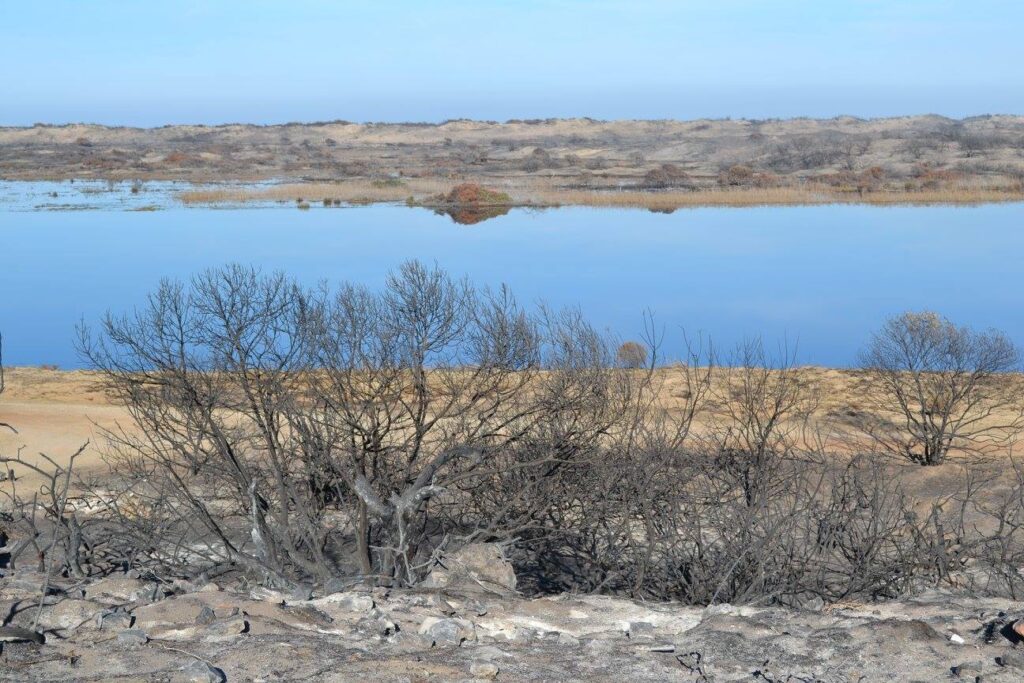
Veld fires are a big challenge as they destroy the plants that bees need for nectar and pollen. Source: Tisha Steyn
The plants in the area must provide enough nectar that provides the bees with carbohydrates, and which can be developed into honey, as well as pollen, which provides the bees with protein. Some plants provide lots of nectar that is not always suitable as honey – some Euphorbia species, like honey euphorbia, and bitter almond (Brabeium stellatifolium), provide bitter-tasting honey.
It is advisable to have different sources of forage available so bees will have access to feed throughout the year. If there is not enough forage during the winter months or a drought, it may be necessary to provide supplementary feed, but more about that in Part 6.
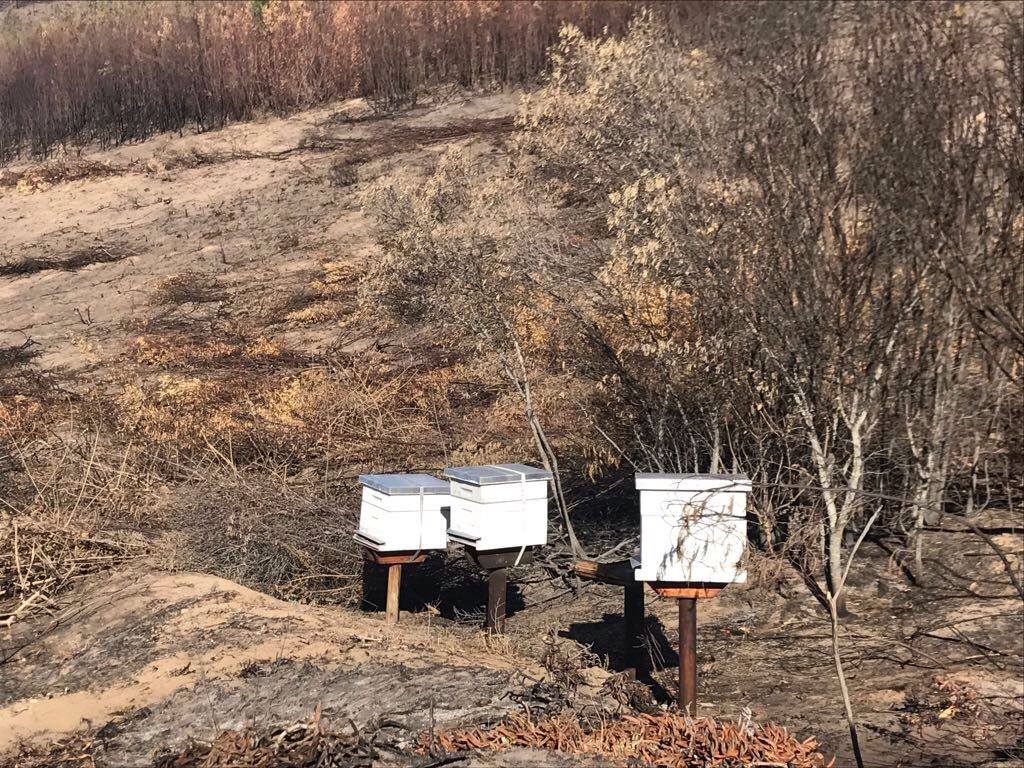
These hives miraculously remained intact during a fire. Note the metal stands on which the hives are mounted to keep badgers at bay. (Source: Provided)
Water
Bees must have access to clean water for breeding as well as regulating the temperature inside the hive. It seems bees prefer water that is slightly heated by the sun. If a tank or drum is used to store water, a piece of wood that floats on top will provide a safe place for the bees to sit while they drink. Dripping water through a pipe from the drum into a sand filter pan or trough will also provide safe drinking water and prevent the bees from falling in and drowning.
Climate
Honeybees are the main pollinators of more than seventy percent of the world’s cultivated crops. As bees depend on the temperature of the environment, climate change that may bring about higher temperatures and longer periods of drought may have a direct influence on their biology, behaviour and distribution. Indirectly, climate change can lead to fewer flowers, which will provide less food for the bees.
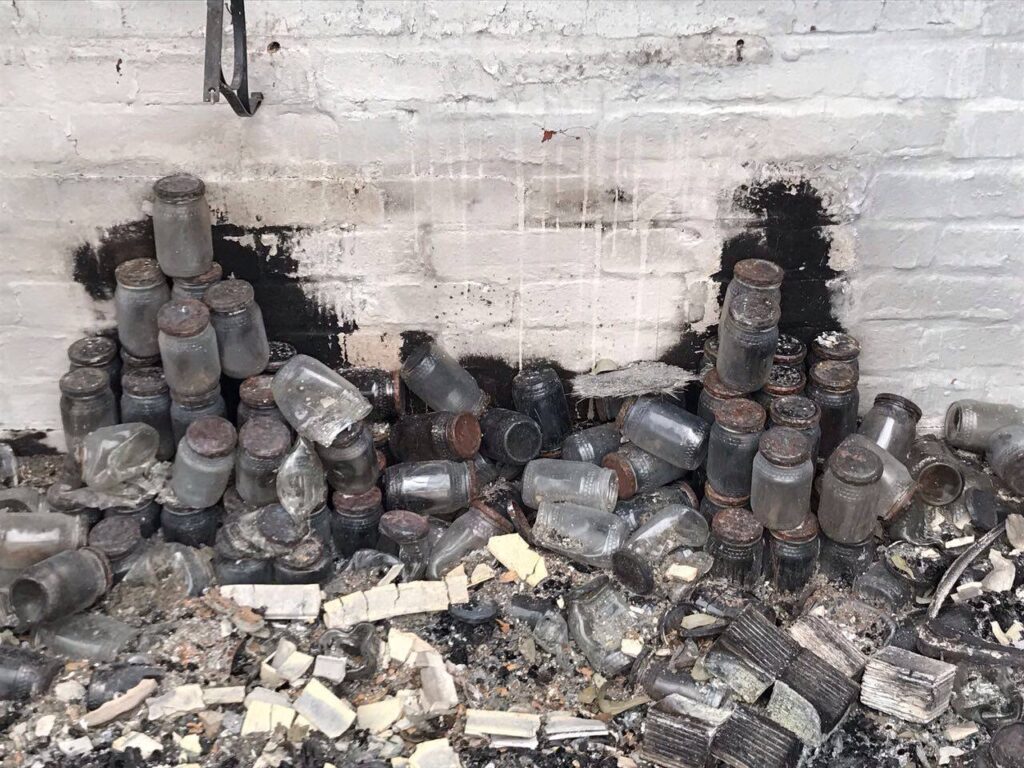
A bottling facility was destroyed by a fire. (Source: Provided)
Bees work optimally between 16 and 32 °C, and the temperature inside the hive is kept at a constant 35 °C. To survive the cold of winter and the heat of summer, the bees employ heating and cooling strategies, mostly by positioning themselves and fanning their wings to thermoregulate their hives.
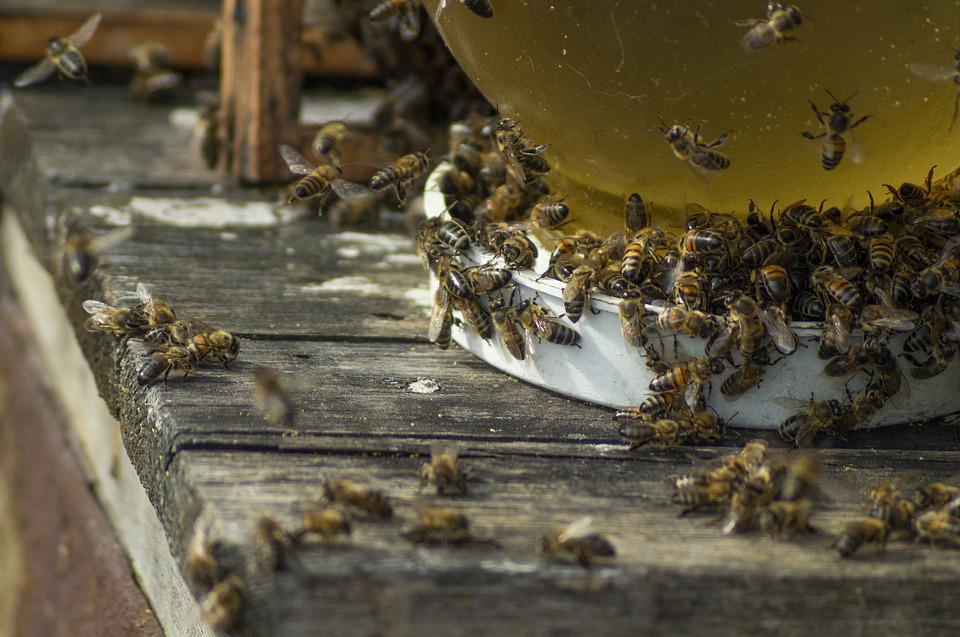
Additional feed, such as sugary water, must be provided for the bees in lean times. (Source: Pixabay)
The general flight activities of bees are influenced by the weather, and they will not forage during rain and thunderstorms. Under these circumstances plants do not usually release pollen, but if they do, it will probably be washed away.
Poisoning of bees
Most insecticides used on agricultural crops are poisonous for bees. Insecticides are divided in three classes according to their toxicity to bees. Some insecticides are less toxic, while others can continue to kill the bees even days after it had been sprayed.
Signs of poisoning and the effect thereof can be seen inside the hive. Bees may appear to be paralyzed, shaky and crawl about. The guardian bees at the entrance may be more active than usual because they will be throwing out the dead and dying bees. After a while, a heap of dead bees may be found in front of the entrance. Toxic pollen and nectar brought into the hive can cause the nursing bees feeding the larvae to die, and therefore the brood may be neglected, and the swarm will suffer.
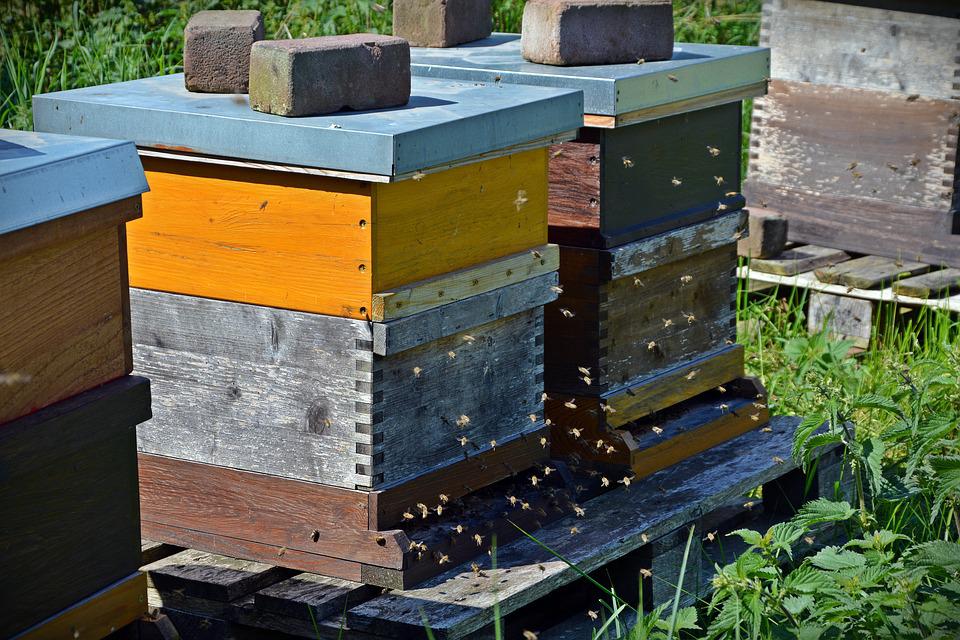
Putting the hives on stands and weighing down the lids may keep some predators at bay. (Source: Pixabay)
Fieldworker bees are usually killed first, either directly by the insecticide, or by just walking over an area that had been sprayed. The swarm’s water source may also be poisoned.
Farmers can help to minimise the effect by informing the beekeeper in advance when spraying will take place.
Bees must be moved away – about eight kilometres from the area that will be sprayed is deemed safe. In the case of some insecticides, the bees can only be brought back to the area after three days.
It helps to cover the hives, but provisions must be made to allow sufficient ventilation, additional space for bees to group together, and access to uncontaminated water.
The hives should be covered the evening before spraying will take place and opened the morning after spraying, but only after the dew has evaporated. The wet poison is deadly, but the toxicity diminishes once the poison is dry. Care must be taken to prevent the drift of the poison to adjacent fields or orchards due to wind.
Enemies
Bees have lots of natural enemies that feed on them.
Pirate wasps
These include predators such as the banded bee pirate (Palarus latifrons). This predatory wasp is mostly found at nest entrances while the female watches from her nearby nest. She catches bees returning from foraging in flight and carries them to her nest, usually in sandy soil, in which she buries up to three bees.

A paper wasp, here seen in its typical nest, is another enemy of the honeybee. (Source: Pixabay)
Sometimes the female wasp falls to the ground with the bee she has caught, and as soon as the bee stops struggling, she forces her mouth into that of the bee and by pressing her curved backside, she forces the contents out of the bee’s honey stomach. Once done, she leaves to find another meal.
Sometimes, when there are hundreds of wasps around, the bees stop working altogether and remain inside the hive. The wasps can completely decimate a bee colony.
The best solution to this problem is to move the bees away or to lure the bee pirates into water traps with a mirror in it. A dish is filled with water and a small quantity of kerosene, and when the wasps dive into the water they are killed by the kerosene.
The yellow bee pirate or beewolf (Philanthus triangulum) is a less destructive wasp that mostly preys on foraging bees.
European wasps
The yellow jacket (Vespula germanica) has been present in the Western Cape for almost forty years and appears to be spreading. They build huge nests and predate on bees that move in and out of the hive but do not seem to do real damage. The European paper wasp (Polistes dominulus) was found in the Cape in 2009 and seems to be spreading rapidly. No record of predation on bees exists.
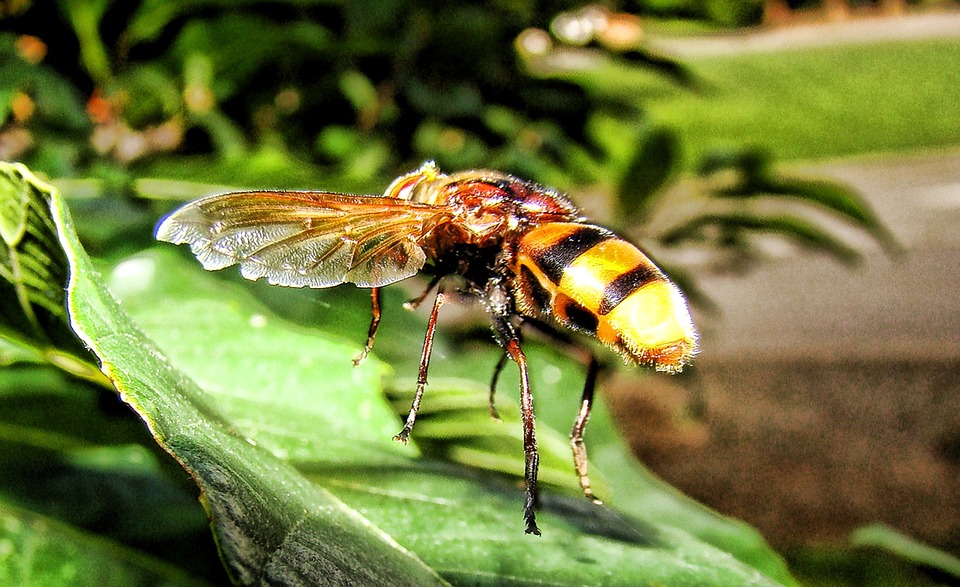
The yellow jacket wasp is an alien species that preys on bees. (Source: Pixabay)
Birds also prey on bees. They may stop bees from foraging, but the interruption is usually temporary. These birds include some bee-eaters (Merops apiaster), Alpine swifts (Apus melba) and the fork-tailed drongo (Dicrurus adsimilis). There is no real solution to the problem, except maybe putting the colonies in bushes to limit the birds’ effect.
- The carmine bee-eater is one of several bird species that feed on bees. (Source: Pixabay)
- The fork-tailed drongo feeds on bees. (Source: Pixabay)
- Swallows catch bees in flight. (Source: Tisha Steyn)
Mice and toads sometimes get into the hives, but they cause only a minor nuisance. They eat the honey and pollen and make a mess, but small entrances should keep them out.
Baboons cause problems in some areas. To limit the damage, the hives can be strapped to keep the baboons out.
- A troop of baboons can wreak havoc in an apiary. (Source: Pixabay)
- Baboons sometimes break open hives to feed on the honey. (Source: Pixabay)
Honey badgers can cause havoc when other food is scarce, especially near natural vegetation. Male badgers can destroy apiaries. This led farmers to set gin traps and use other unethical ways of capturing the badgers, but consumer pressure advocating badger-friendly honey has mostly put an end to the remorseless killing. Hives placed on stands of 1,2 meters above ground, straps or fastening the hives to the ground, or hanging bee colonies in trees, will keep the badgers at away.
Ants, including the Argentine ant (Linepithema humile), brown house ant (Phedole megacephala), pugnacious ant (Anoplolepis custodiens) and driver ant Dorylus (Anomma), can be a real problem. Poison is not a good solution – it is best to keep the ants out of the hives. Raise the hives on pedestals and use ant barriers like Plantex around the pillars. Termites can devour a wooden hive, but the same treatment should work for them – keep the hives out of their reach.
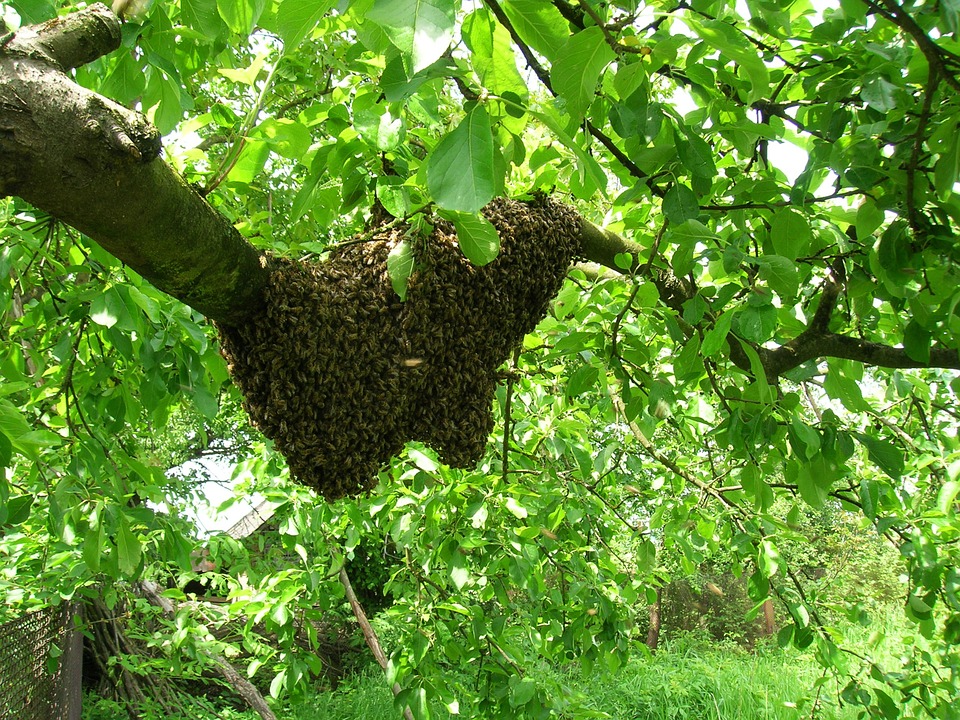
Swarming is a natural occurrence, but some beekeepers may regard it as a challenge. (Source: Pixabay)
Theft and vandalism
Theft and vandalism are problems caused by humans who break into even enclosure apiaries, break open the hives and steal the honey. There is not much you can do about it, apart from keeping defensive bees!
Climate change and the associated prolonged droughts may cause more wildfires in dry areas. These are also often caused by humans who intentionally or by accident set the veld alight. The best way to prevent fires
from destroying your apiary is to keep the area around it free of vegetation.
Disease is another challenge, but the different diseases will be discussed in future issues.
References
Allsopp, M. (2000) Predators of bees in Southern Africa. Agriculture Research Council (ARC) https://rr-africa.woah.org/wp-content/uploads/2000/11/34_allsopp.pdf
Anderson, R.H., Buys, B., Johannsmeier, M.F (2014). Byeboerdery in Suid-Afrika Hersiene uitgawe. Departement van Landbou-tegniese Dienste. Bulletin no. 394, 1978
Jarimi, H., Tapia-Brito, E. and Riffat, S. (2020). A Review on Thermoregulation Techniques in Honey Bees’ (Apis Mellifera) Beehive Microclimate and Its Similarities to the Heating and Cooling Management in Buildings. Future Cities and Environment, 6(1), p.7. DOI: http://doi.org/10.5334/fce.81 https://futurecitiesandenvironment.com/articles/10.5334/fce.81/
Reddy, P.V. R., Verghese, A., Rajan, V.V. (2012) Potential impact of climate change on honeybees (Apis spp.) and their pollination services. Division of Entomology and Nematology Indian Institute of Horticultural Research, India. Pest Management in Horticultural Ecosystems, Vol. 18, No. 2 pp 121-127. http://www.nicracar.in/nicrarevised/images/publications/Research_art/HRT20_Potential%20impact%20of%20climate%20change.pdf

